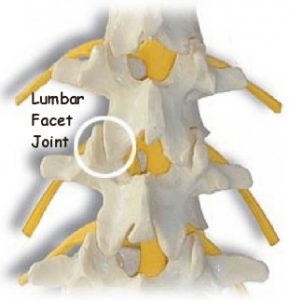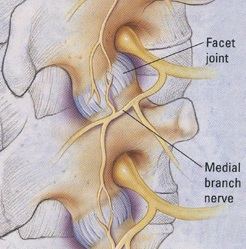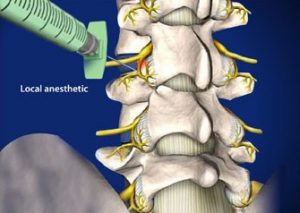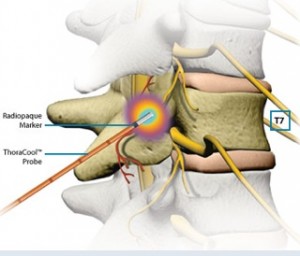What Causes Facet Joint Pain?
The joints connecting each level of the spine are called facet joints. They are about the size of a thumbnail and are located on either side of the spine at every level, from the neck down to the sacrum.
Since they contain cartilage similar to other joints in the body like the hip and knee (just much smaller), they are prone to arthritis. This may lead to pain as a result emanating from these joints due to “wear and tear” degenerative arthritis. Or injury to these joints may occur from a trauma such as a car accident to the cartilage itself or the soft tissues  surrounding the area.
surrounding the area.
Either way, pain coming from the facet joints is called Facet Syndrome, and usually responds quite well to medial branch blocks.
What is a Medial Branch Block?
The words “medial branch” refer to the small nerve endings that provide sensation to the facet joint itself. They are not nerve roots, but tiny little nerve endings that come off of nerve roots as they come out of the spine and then travel around to the facet joints on either side.
Joints themselves have a sensory supply which is how they can feel pain. For the facet joints, medial branches are those small nerve endings. So the Medial Branch “block” procedure stops the sensation being transmitted in those nerve endings. The procedure involves an injection around the joint where these nerve endings travel. It does not go into the joint itself.
Call (602) 507 – 6550 to Get Started Today or

Why is a Medial Branch Block performed?
Individuals with neck, mid-back, or low back pain are often suffering from facet syndrome. Surgery for facet arthritis leads to poor outcomes, as if a person has arthritis at one level they likely have it at multiple. Fusing multiple levels is not risk-free, and often leads to adjacent level accelerated breakdown.

So the best option is nonoperative management of facet syndrome. And that is where medial branch blocks enter the picture. There are two reasons for having a Medial Branch Block performed:
- Diagnostic – if it is not clear that the facet joints are causing the neck, mid, or low back pain, a diagnostic medial branch block can tell the pain management doctor a lot. If it relieves the pain, it has diagnosed the facet joints as the problem causing pain. If it doesn’t work at all, it’s back to the drawing board to find out the pain generator.
- Therapeutic – This means the medial branch block is performed to bring about pain relief. Most medial branch blocks are performed for both diagnostic and therapeutic reasons.
How is a Medial Branch Block Performed?
These injections are done as an outpatient. Typically intravenous sedation is not required, however if a patient is anxious it can be utilized. One middle ground approach is for the patient to take a Valium by mouth 30 minutes prior to the procedure.
During a medial branch block, the injected medicine “blocks” the nerves supplying sensation to the painful facet joint. Individuals lay on their stomach on a table that allows x-ray beams to go through it. The doctor injects a local anesthetic to numb the skin and all

Medial Branch Block
significant pain relief from the procedure, another level can be treated to evaluate it as the source of the pain.
There is considerable debate over whether the medial branch block should consist of only numbing medicine or if cortisone should be included. Studies looking at medial branch blocks with lidocaine plus or minus corticosteroid have shown that both work well, and each injection typically provides about 5 months of relief, providing on average over 50% pain relief.
After a medial branch block, patients may go home within about an hour. The procedure may be repeated every few months, or if desired the patient my receive a radiofrequency ablation (RFA) as a next step. If adequate relief was obtained from the medial branch block (50 to 80% pain relief), insurance companies will typically approve the RFA.
What are the Outcomes of Medial Branch Blocks?
Strong evidence has been shown for the effectiveness of cervical and lumbar facet diagnostic injections as being accurate for diagnosing the facet joint as the source of a patient’s neck or low back pain.
With the diagnostic injection into the cervical facet joints, the magic number for percent pain relief is 80% reduction. Some insurance companies use 50% reduction as the “magic number”, but studies are now showing that 80% pain relief is more accurate.
If 80% pain relief is achieved, then insurance companies typically approve additional treatments such as a radiofrequency ablation (RFA). This procedure involves deadening the

Radiofrequency Ablation
medial branches with a high temperature, and may provide pain relief for one to two years! To read more about the RFA procedure, CLICK HERE.
Overall, medial branch blocks have shown an average of 5 months of pain relief, whether or not steroids are included along with the numbing medicine. Very impressive indeed.
What are the Risks of a Medial Branch Block?
The risks of a medial branch block are small but real. There is a risk of infection, nerve injury, or bleeding. If a person is taking blood thinners, they should be stopped a week or so prior to the procedure (your Arizona pain management doctor will give specifics on time frame). There is also a risk of the injection not working for pain relief.
If cortisone is injected, there is a risk of a temporary elevation of blood sugars, weight gain, or water retention.
If you are suffering from neck, mid-back, or low back pain, it may be facet related pain. Let the expert pain management doctors at Arizona Pain Specialists help.
Arizona Pain Specialists offers the Best AZ Pain center doctors. All are Board Certified, and the practice has won multiple TOP DOC and FOUR Patient’s Choice Awards in a Row!
Call (602) 507 – 6550 to Get Started Today or
